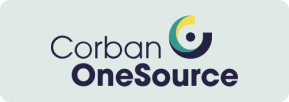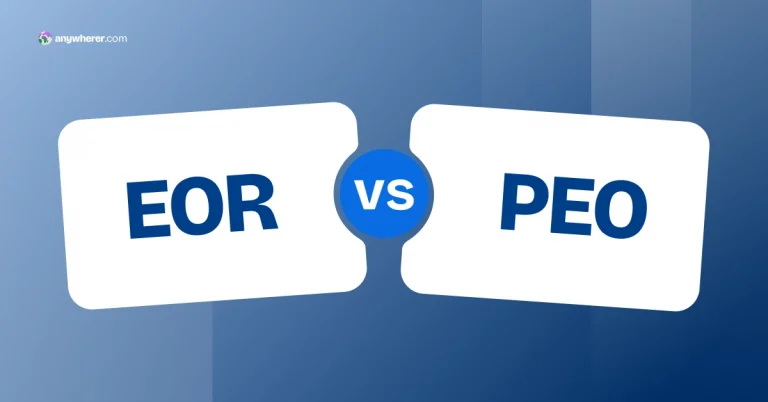As growing businesses face increasing competition and the operational complexities of global employment, Professional Employer Organizations (PEOs) and Administrative Services Organizations (ASOs) are gaining momentum. But which model is better suited to your specific business needs?
Choosing between a PEO and ASO isn’t just about services — it’s about how much control, risk, and flexibility your company wants to retain. Therefore, in this comparison, we’ll break down how each model works, which employee benefits PEO & ASO provide, where their responsibilities differ, and help you determine which one aligns best with your company’s needs.
PEO vs ASO: Quick Overview of Key Differences
First and foremost, the main difference between a PEO and an ASO lies in legal responsibility: a PEO shares liability through co-employment, while an ASO offers support without sharing it.
While both models offer payroll processing, HR services, and benefits administration, the key distinction between the two impacts how liability is managed, who controls compliance, how benefits are sourced, and overall scalability. Explore the table below to better understand the differences between PEO and ASO meaning and functions.
ASO vs PEO: Key Differences
Comparison Factor
PEO
ASO
Co-Employment Model
Co-employer shares legal responsibilities
Employer retains full legal responsibility
Payroll & Tax Compliance
Managed by PEO under their EIN
Managed by ASO under the client’s EIN
HR & Benefits Administration
Comprehensive, often with access to large-group benefit plans
Administrative support, client sources their own benefits
Access to HR Tech & Tools
Included as part of bundled service
Included as part of bundled service
Risk & Compliance Responsibility
Shared – PEO assumes partial liability for compliance
Client retains full liability and risk
Employee Onboarding & Contracts
Handled by PEO with standardized contracts
Support provided, but client retains ownership
Workers’ Compensation & Insurance
Covered under PEO’s master policy
Client must provide their own coverage
Flexibility & Scalability
Less flexible – more contractual obligations
More flexible – services can be unbundled
Termination Process
Can be complex due to co-employment and shared responsibilities
Simpler – client retains control over employment decisions
Reviewing PEO Model: All You Need to Know
In this section, we’ll break down how the PEO model works, what services it includes, and why it’s a valuable solution for growing companies.
PEO Definition
PEO is a model based on partnering with a company to manage key HR responsibilities. While the PEO takes on certain administrative and compliance duties, the company remains the legal employer and must have (or establish) a legal entity wherever it operates.
PEO Model Purpose
When it comes to the purpose and mission of PEOs, no one can describe it better than the providers themselves. Below are mission statements from some of the leading PEO companies.
“To help businesses succeed so communities prosper.” – Insperity
“To help entrepreneurs and businesses grow with confidence.” – Justworks
“To give business owners and HR leaders the freedom to grow their business.” – ExtensisHR
Aimed at fulfilling this mission, PEO providers are commonly responsible for the following business results:
- Accurate, on-time payroll processing that reduces errors and saves administrative time.
- Reduced legal and regulatory risks and minimized potential penalties.
- Better talent attraction and retention through standardized processes, competitive compensation and benefits.
- Peace of mind from shared legal and operational efficiency without expanding in-house HR teams.
With these benefits in mind, let’s explore a portfolio of services commonly offered by PEO providers.
Key PEO Functions

Payroll and tax administration

Risk and compliance management

Employee lifecycle management
Global hiring support

Benefits administration

Multi-country employment
PEO Model Cost
So, how much does a PEO cost, and how can it impact the overall partnership? A PEO may seem more expensive than an ASO, but the cost reflects its co-employment model and shared legal liability — since PEOs file under their EIN, often securing better benefits and reducing compliance risks.
PEO cost structure essentials include:
- Typically charging either a % of total payroll or a flat monthly fee per employee;
- Includes bundled services like payroll, tax filing, benefits, and HR support;
- Often offers better benefits rates through group plans.
ASO Essentials: A Clear-Cut Guide
Moving on, let’s dive into the ASO definition, explore how ASO services stand out, and discover who they’re best suited for.
ASO Definition
An ASO is a model in which a service provider assists businesses with core HR functions without entering a co-employment relationship — thus, unlike PEOs, operating under the client’s EIN while the client retains full legal responsibility.
ASO Model Purpose
ASO collaboration brings multiple advantages for businesses, many of which are reflected in the mission statements of leading ASO providers. See a few of them below.
“We make it simple for businesses of all sizes to pay and manage their employees. We make their payroll easy and automatic.” – Paychex ASO
“Delivering world-class HR services that empower people to achieve their dreams and pursue their passions.” – G&A Partners
“We aim at providing outstanding customer support, expertise, and the resources needed to help our clients quickly reach higher levels of success.” – Questco
ASO providers typically deliver the following business benefits:
- Accurate, streamlined HR and payroll operations through administrative assistance.
- Reduced administrative burden without entering a co-employment agreement.
- Full ownership of compliance, vendors, and employment decisions.
- Scalable structure for companies that want to expand while keeping HR in-house.
These benefits are vividly exemplified in the suite of ASO functions. Explore them below:
Key ASO Functions

Payroll management

Tax administration

Compliance guidance

Benefit administration

HR administration

HR technology integration
ASO Model Cost
In comparison to a PEO, an ASO is often more affordable on a per-employee basis. However, companies using ASOs must handle their own legal responsibilities, tax filings, and benefit sourcing, which may require additional internal resources or legal oversight.
Several essential aspects related to ASO cost:
- Typically charges a flat monthly fee or per-service pricing.
- Offering unbundled services, so businesses only pay for what they need.
- No co-employment — the company retains full legal responsibility, which can lower service costs.
Key Difference Between ASO and PEO in Detail
Legal and Compliance Responsibilities
In terms of legal responsibilities, ASO acts strictly as a service provider. In doing so, it assists with HR processes such as payroll, benefits, and compliance guidance — but the company retains full legal responsibility for labor law compliance and employee-related risks. The ASO does not share or assume any legal liability.
ASO and Legal Compliance: Key Takeaways
Official Employer
Employer Responsibilities
Liability for Labor Law Compliance
ASO does not appear on contracts
All employment obligations remain with the company
ASO only provides admin support and guidance
A PEO, in turn, enters into a co-employment relationship, sharing some employment-related responsibilities and liability. This way, while the company still has operational control, the PEO takes over payroll tax filings and assumes partial liability for HR compliance — thus reducing the business’s exposure to regulatory risk.
PEO and Legal Compliance: Key Takeaways
Official Employer
Employer Responsibilities
Liability for Labor Law Compliance
Co-employment model
Shared
Shared
Payroll & Tax Compliance
In the ASO model, the business is fully responsible for payroll accuracy, tax withholdings, and filings. The ASO may assist with payroll processing, but all taxes are filed under the company’s own Employer Identification Number (EIN).
ASO and Payroll Compliance: Key Takeaways
Payroll Processing
Tax Responsibility
Compliance Ownership
ASO assists with setup and processing, but payroll runs under the company’s name
All payroll taxes are filed under the company’s, not ASO’s, EIN
Not handled by ASO
In contrast, a PEO directly manages payroll under its own EIN and takes on full responsibility for tax withholdings, filings, and payroll compliance. This can reduce administrative burden and lower the risk of tax-related penalties, particularly for businesses without a dedicated in-house payroll team.
PEO and Payroll Compliance: Key Takeaways
Payroll Processing
Tax Responsibility
Compliance Ownership
The PEO processes payroll on behalf of the company
Payroll taxes are filed under the PEO’s EIN
Handled by PEO
HR & Benefits Administration
An ASO model implies that the provider offers administrative support for HR tasks, but the company is responsible for sourcing and managing its own benefits packages. This setup allows for greater customization but less purchasing power compared to PEO models.
ASO and Benefits Administration:
Key Takeaways
Benefit Offering
Customization
Cost Efficiency
The company must source and manage its own employee benefits
Full control
Typically higher costs due to lack of access to group rates offered through pooled plans
Unlike the ASO collaboration, a PEO offers access to large-group benefit plans negotiated under the PEO’s umbrella, often including health, dental, vision, and retirement options. This not only simplifies administration but can also result in lower premium costs for employers. However, customization may be more limited due to standardized plan options.
PEO and Benefits Administration:
Key Takeaways
Benefit Offering
Customization
Cost Efficiency
Comprehensive benefit packages
Limited flexibility due to pre-selected plans
Greater savings due to access to large-group benefits
Risk Management
Speaking of risk management, the ASO provider offers tools, templates, and general HR guidance — but the business is fully responsible for ensuring compliance with employment regulations. The ASO can help avoid penalties by advising on best practices, but it does not bear any legal liability if a claim or violation occurs.
ASO and Risk Management:
Key Takeaways
Labor Law Compliance
Penalty Prevention
Legal Claims
Not handled by ASO
ASO may offer guidance and alerts, but enforcement and adherence are up to the client
Not handled by ASO
Meanwhile, in a PEO model, co-employment allows the provider to share responsibility for legal compliance. The PEO often manages HR policies, ensures regulatory updates are implemented, and assumes partial liability in employment-related legal matters. This shared risk model helps companies avoid fines and reduces exposure to costly claims.
PEO and Risk Management:
Key Takeaways
Labor Law Compliance
Penalty Prevention
Legal Claims
Handled by PEO
The PEO helps enforce up-to-date policies
The PEO may assume partial liability
Scalability and Business Growth Suitability
When it comes to scalability, an ASO model offers flexibility and allows companies to pick and choose services based on their current needs. ASOs also make it easy to switch vendors or services over time, offering modularity as the company grows. However, global expansion support is limited, as ASOs typically focus on domestic compliance and administration.
ASO and Scalability: Key Takeaways
Flexibility
Switching a Model
Global Expansion
Customizable services
Easy to scale or move to a PEO
Limited
In comparison to ASO PEO partners are ideal for companies looking to offload HR and compliance quickly. With bundled services and shared legal responsibility, it enables growth without building internal HR teams. Many PEOs also support international hiring or offer transitions to EOR models. While switching from a PEO can be complex, it’s manageable as businesses scale.
PEO and Scalability: Key Takeaways
Flexibility
Switching a Model
Global Expansion
Moderate — due to bundled services
Transitioning out may require more effort
Many PEOs support international hiring or connect to EOR options
Choosing Between PEO vs. ASO: Top Factors to Consider
Whether you prioritize flexibility, liability coverage, or benefit access, your choice between an ASO vs. PEO will impact day-to-day operations. So which one to choose — PEO or ASO? See the checklist below to guide your decision.
ASO versus PEO Cheatsheet:
Finding the Right Fit
Scenario
Best Model
Why?
You want HR and payroll support but retain full employer control
ASO
ASO offers admin support without co-employment — your company stays the legal employer
You need access to large-group benefit plans
PEO
PEOs offer benefits under their umbrella plans, hence more competitive rates
You already have a strong internal HR team and only need payroll/compliance help
ASO
ASOs let you choose only needed services while keeping HR decisions in-house.
You prefer a bundled, scalable HR solution for long-term growth
PEO
PEOs offer an all-in-one HR infrastructure ebsuring high efficiency
You want flexible, à la carte HR services
ASO
ASOs provide more customizable, unbundled services
You are concerned about compliance liability and want shared risk
PEO
PEOs share certain legal and compliance responsibilities
You prefer more control over vendor choices, benefits, and tools
ASO
With ASO, clients choose their own benefits, insurance, and HR tools
Navigating the Top Industry Providers of ASO and PEO Services
With key PEO/ASO essentials now covered, the question remains: which companies are truly driving the market forward? Let’s take a closer look at the top players defining today’s PEO and ASO industry landscape.
Prominent PEO Companies
One of the largest PEOs providers in the U.S. for tech-powered HR and payroll efficiency.
The market leader in PEO services for remote teams that makes the management of US teams easier.
User-friendly, modern, certified PEO platform to manage employee benefits, payroll, HR, and compliance.
A PEO software helping businesses automate HR operations, benefits, and compliance workflows.
A specialized PEO provider delivering small and medium-sized businesses full-service HR solutions.
Must-Know ASO Providers

Providing customized, integrated claims solutions supported by industry-leading expertise and technology.

The industry-leading partner in HR outsourcing, benefits administration, and payroll administration.

Consolidating payroll and HCM technology, high-touch support, and full-service HR outsourcing.

Delivering integrated and customizable services.

A digital transformation champion in the staffing and recruitment.
Companies Offering Combined PEO and ASO Services

Aimed at simplifying employment complexities through integrated solutions.

Providing hands-on, expert PEO & ASO HR services to help businesses minimize costs and maximize efficiency.

A trusted PEO provider empowering full-service HR outsourcing and administrative services.

A leading provider of integrated human capital management solutions.

An efficient PEO & ASO HCM solutions provider simplifying global employment for small businesses.
FAQs on PEO ASO Models
What is the key difference between PEO and ASO?
The major ASO PEO difference lies in employment responsibility. A PEO enters a co-employment relationship, sharing certain legal and compliance liabilities with your business, while an ASO provides administrative support only, with your company retaining full employer responsibility.
How do I determine whether my business needs an ASO or a PEO?
If you want to outsource HR functions but keep full control and legal responsibility, an ASO is likely the right fit. If you prefer to offload more compliance risk, access pooled benefits, and work within a co-employment structure, a PEO is typically the better choice.
Can a company switch from an ASO to a PEO (or vice versa) later?
Yes, many providers offer ASO and PEO services, and businesses can switch as their needs evolve – for example, moving from an ASO to a PEO when expanding operations or requiring more integrated compliance support.
Which model is more cost-effective in the long run?
ASOs may be more affordable upfront, especially for companies with in-house HR or benefits solutions. However, PEOs can be more cost-effective long term by offering access to group benefits, reducing compliance risk, and saving time on HR administration.
Does one model provide more flexibility than the other?
ASOs are generally more flexible, offering à la carte services and allowing you to choose vendors and tools. PEOs offer bundled services, which may be less customizable but provide more comprehensive support.
Gain key insights into how ASO and PEO offerings impact business growth and compliance.

Yaryna is our lead writer with over 8 years of experience in crafting clear, compelling, and insightful content. Specializing in global employment and EOR solutions, she simplifies complex concepts to help businesses expand their remote teams with confidence. With a strong background working alongside diverse product and software teams, Yaryna brings a tech-savvy perspective to her writing, delivering both in-depth analysis and valuable insights.


